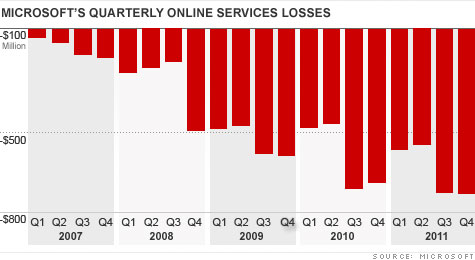Way too often do I hear from the Microsoft fans that the company is catching up with Google. Each and every time I disagreed, but in the heat of the discussion it’s not always easy to find supporting facts. Yeah, I know, I should come ready for such arguments, but I really take them when and where they find me.
Anyways, Google Android and Microsoft Mobile is only one side of a discussion. Advertising is the other. And search is yet another one. Well, I’ve heard the numbers before, but never bothered blogging them. This time I will. Slashdot links to a CNN Money article, which tells a really sad story.
Microsoft (MSFT, Fortune 500) has lost $5.5 billion on Bing since the search service launched in June 2009, but the company’s search losses actually pre-date that. In fact, the software giant has never made money in its online services division. Since Microsoft began breaking out that unit’s finances in 2007, the company has lost a total of $9 billion.
There is even a little visual aid in case you prefer your trends simplified. It doesn’t look good, and it will never will. And the secret is very simple. Microsoft is not an online company. It never was and it is too large to change. If it will ever change, it will be as different from what it is now as IBM is different from the company it used to be in the last century.

